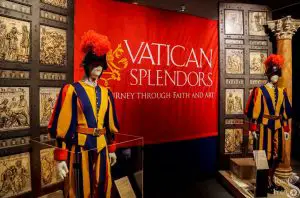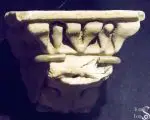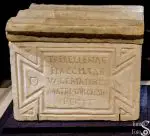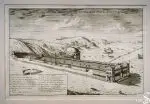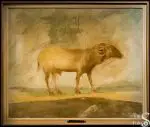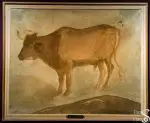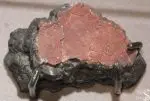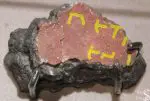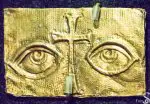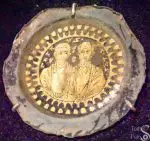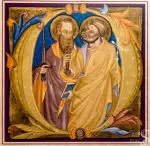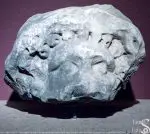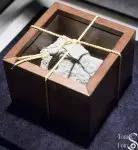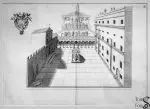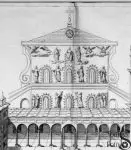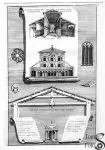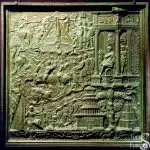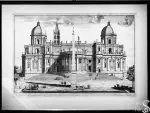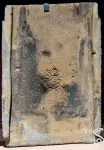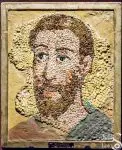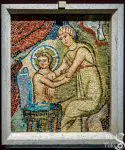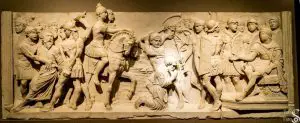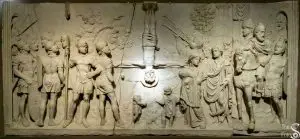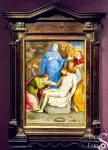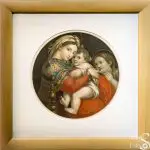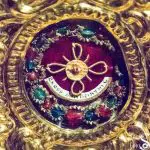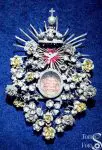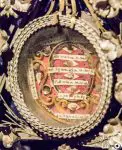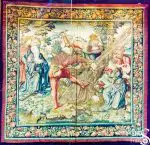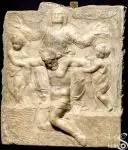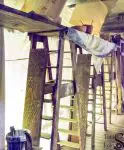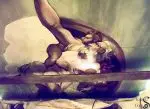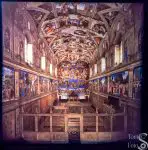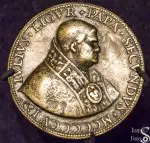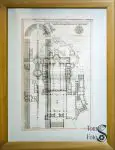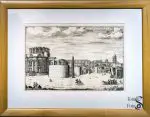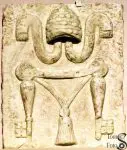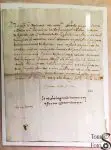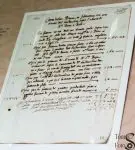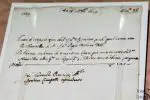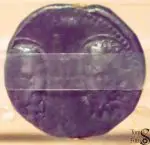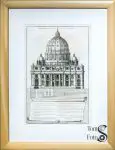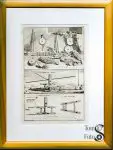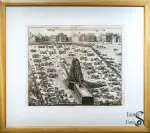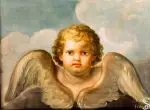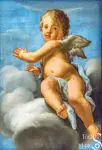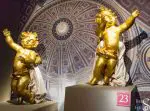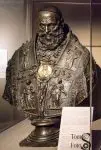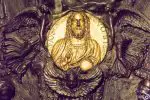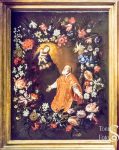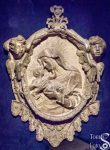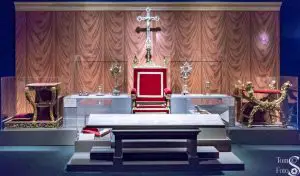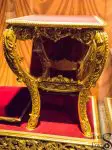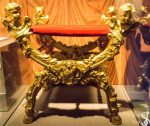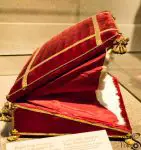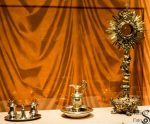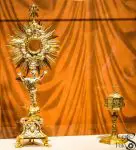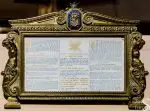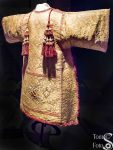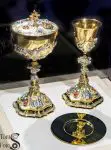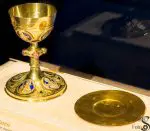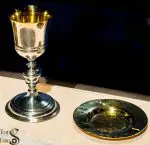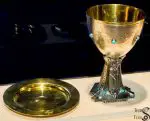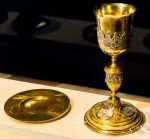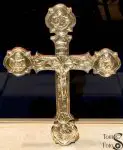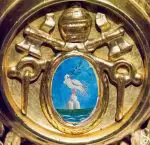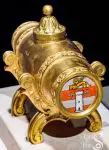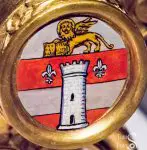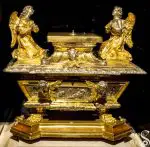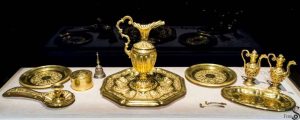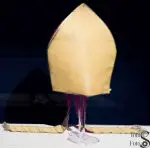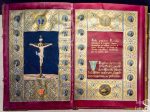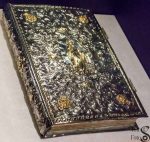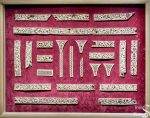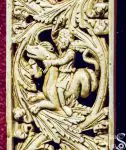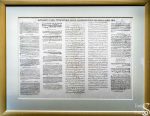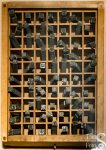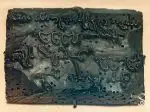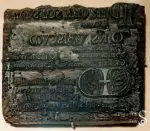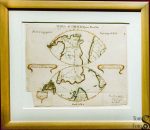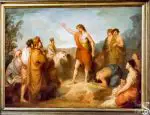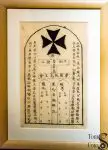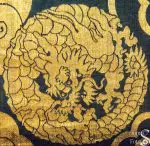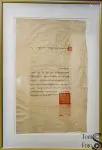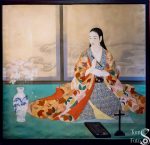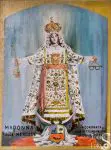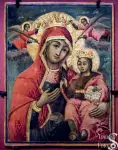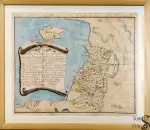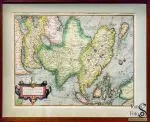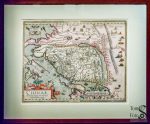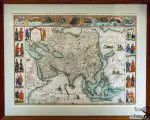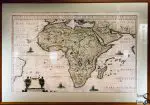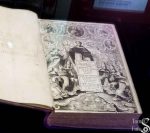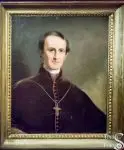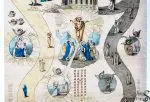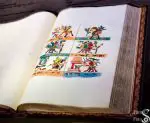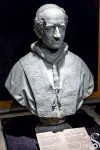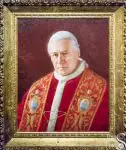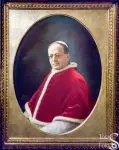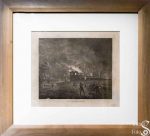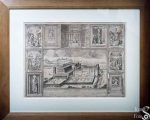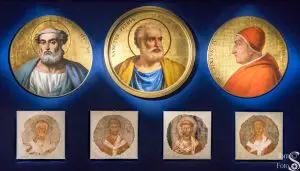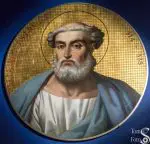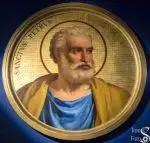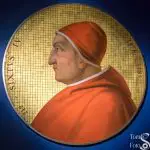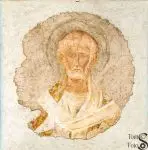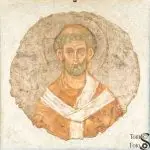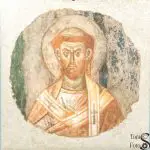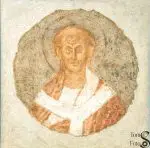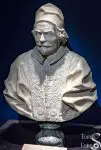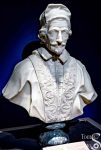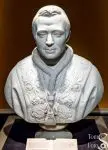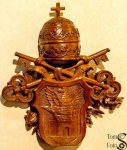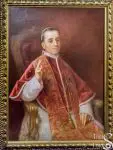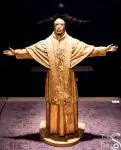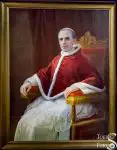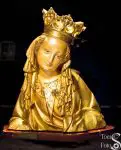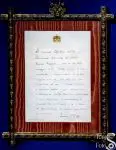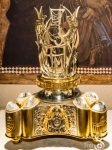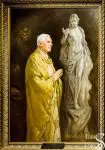From March through early September 2016 the Ronald Reagan Presidential Library hosted the exhibit titled Vatican Splendors; one of only two locations in the United States the exhibit was shown in its year away from the Vatican. The exhibit was organized by Texas company Evergreen Exhibitions. All copyrights and trademarks are the property of their owners. TomsFotos only claims copyright to the photos taken, with permission, at the exhibit. If you desire photos of the exhibit for commercial or other use please contact Evergreen Exhibitions. None of the photos here are authorized for use by others.
The photos below were taken over the period the exhibit was in place and show, to the extent possible, all the material exhibits on display. There was much more provided as text descriptions; these are not shown here.
The exhibit was organized into several different sections largely based on historical progression from Saint Peter through today. The presentation here is organized in a similar manner using the titles of the exhibit sections. [Photos on this page can be enlarged by clicking on them. Click outside the photo to close the box it displays in. Hover your mouse pointer over words with dotted underlines and a definition should appear in a tool-tip box.]
Lets go into the exhibit now…
Vatican Splendors Gallery 1: Early Christian Dialogue Between Faith and Art
Vatican Splendors Gallery 2: The Rise of Christian Rome
The conversion of Roman Emperor Constantine marked the start of Christians being seen in a much different light. He moved the capital of the empire to Constantinople and Rome became a Christian city. Christian culture thrived under the patronage of popes.
Vatican Splendors Gallery 3: The Early Renaissance
Vatican Splendors Gallery 4: Michelangelo
Pope Julius II commissioned Michelangelo to work for the Vatican in 1508. The relationship between the Pope and Michelangelo was fiery but resulted in some of the finest art of the time.
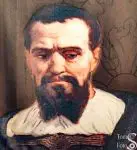 |
The relationship with the Pope over those four years is summarized in two quotes…
Pope Julius II: “When will it be finished?” Michelangelo: “When I can!” |
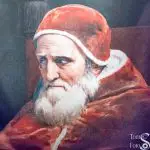 |
Vatican Splendors Gallery 5: The Renaissance Basilica
This gallery starts where the last left off. Pope Julius II was also responsible for starting the new basilica as evidenced by the bronze coin shown here…
Vatican Splendors Gallery 6: Art in the Service of Faith
1511 saw a penniless German friar named Martin Luther visiting Rome and, seeing the new Basilica construction partially funded by the selling of indulgences, writing incendiary materials that spread fast and started the Protestant Reformation. In response Pope Paul III convened a meeting in Trent, Italy to determine Church doctrine and practice. The Council of Trent met from 1545 to 1563 and established guidelines for art which should serve the faith. Examples of art that fits these guidelines populate this gallery.
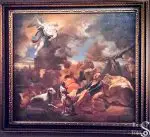
The Announcement to the Shepherds. By a Roman follower of Peter Mulier, well-known as the Cavalier Tempesta in the last quarter of the 17th century. Oil on canvas. |
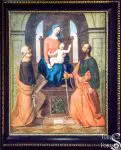
Virgin Mary with Infant Jesus between Saints Peter and Paul. The Madonna and Child is in the Byzantine tradition but the smaller halos and portraits as real people signal early Renaissance. |
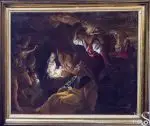
The Nativity. Oil on canvas in the style of painter Giovanni Lanfranco from the 17th century. |

Cope of Saint Charles Borromeo. A cloak made from damask and yellow and pink brocade; usually worn in ceremonial processions. This cope was of Florentine manufacture in the second half of the 16th century. There is a tie-in here to the California missions. Saint Charles Borromeo is the patron saint of the Carmel Mission. |

Madonna with Child. This piece is attributed to Francesco Maria Mazzola, also known as Parmigianino. It is from the 16th century and made with black chalk, brown ink, and watercolor on white paper. |
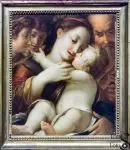
The Holy Family with Two Angels. This oil on canvas represents the Bolognese School. It is a late 16th century piece from Bologna, Italy. |
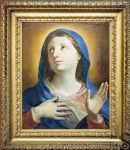
Madonna. This 17th century Madonna is an oil on canvas by the Italian artist Giovanni Battista Salvi, also known as Il Sassoferrato. He painted many such works to meet the demand created by the Counter-Reformation. |
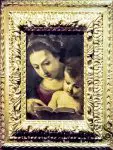
The Virgin Mary with Infant Jesus and Book in Hands. A work attributed to Giovanni Francisco Barbieri, also known as Guercino who was a leading painter of the School of Bologna. It is a 17th century work of oil on paper. (This photo was difficult to take due to the work’s small size and placement with regard to lights and reflections.) |
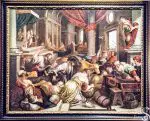
The Expulsion of the Merchants from the Temple. This oil on canvas is from the late 16th or 17th century and painted in the workshop of Francesco or Leandro Bassano. |

The Flagellation of Christ. In the 1570s and 1580s Pope Gregory XIII sponsored Girolamo Muziano who became a famous religions artist. This oil on canvas is part of a cycle of paintings showing the passion of Christ. The cycle, in the sacristy of the canons in the Basilica of Saint Peter could be mediated on as a priest prepared for Mass. |

Portrait of a Prophet. This 17th century oil on canvas hung in the Floreria, the papal wardrobe and storeroom established by Pope Boniface IX at the end of the 14th century. |
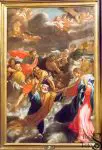
Peter Saved from the Water. This oil on canvas shows the Gospel episode were Jesus appeared walking on water and invited Peter to join Him. Jesus saves him when his faith wavers and starts to sink. It is from the school of Giuseppe Ghezzi circa 1715-1725. |
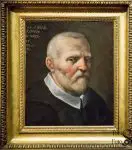
Portrait of Saint Philip Neri. A Roman painter made this oil on canvas in the 17th century. To the right is The Vision of Saint Philip Neri. The artist for this 17th century oil on canvas was the Jesuit brother and Flemish baroque painter Daniel Seghers. It shows a famous episode in the saint’s life where the Virgin Mary restored him to life as he was close to death. |
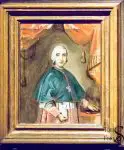
Portrait of Cardinal Niccolò Oddi, Legate of Romagne. In the Middle Ages popes established Papal States which they ruled as monarchs. A region around the city of Ravenna in northeast Italy became one in 756. The region’s name changed to Romagna in 1540. Cardinal Oddi (term: 1766-1767) was the last papal legate of Romagna as Napoleon’s invasion of Italy and the 1797 Treaty of Tolentino ended Romagna as a Papal State. |
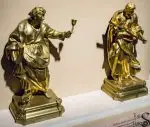
Statues of Saints John and Andrew. 19th century gilt metal statues. Saint John was often depicted with an eagle but here shown with a chalice representing the legend he drank poison and survived. Saint Andrew is shown with the X-shaped cross used as the method of his martyrdom. |
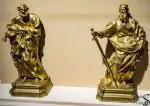
Statues of Saints Peter and Paul. 19th century gilt statues. Saint Peter is shown with the keys to the kingdom while Saint Paul of usually shown with a sword representing his life prior to conversion and the method of his martyrdom (beheading). |

The Crucifixion with Darkened Skies. An oil on canvas by the School of Leonard Bramer and dating to the 17th century. |
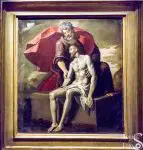
Christ Raised from the Grave by God the Father. By the Italian Mannerist painter Domenico Mona dating to the late 16th century. Oil on canvas. |
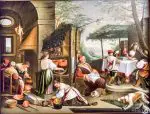
The Supper of Emmaus. An oil on canvas from the workshop of Francsesco or Leandro Bassano dating from 1590-1620. |
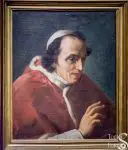
Portrait of Pius VII. This oil on canvas by Vincenzo Camuccini dates to 1814. Pope Pius VII’s term starts in the middle of the French occupation of Rome and six months after the death of Pius VI in a French prison. He was elected pope in 1800 in Venice, not under French control but returned to Rome in 1814 after the fall of Napoleon. This portrait ends this gallery. |
Vatican Splendors Gallery 7: The Art of the Liturgy
You see a good deal of gold in this gallery. Why? The poet Pavel Florensky (1882-1937) summarized it well…
By the flat light of day, gold is crude, heavy, useless, but by the tremulous light of a lamp or candle it springs to life and glitters in sparks beyond counting — now here, now there, evoking the sense of other lights, not of this earth, which fill the space of heaven.
Vatican Splendors Gallery 8: Dialogue with the World
Vatican Splendors Gallery 9: The Successors of Peter – Papal Portraiture
Many papal portraits in many different formats and media have been produced over the 2000 years of the papacy. Such images help people understand the lineage from Saint Peter and help Christians better know and understand their current and past popes. This gallery presents some of those images.
Vatican Splendors Gallery 10: Art and the Contemporary Papacy
The Church today participates in discussions of every aspect of modern life, including art. In 1999, Saint John Paul II stated in a letter:
Every genuine art form in its own way is a path to the inmost reality of man and of the world. It is therefore a wholly valid approach to the realm of faith, which gives human experience its ultimate meaning.
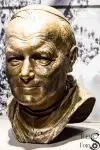
This bronze bust of Saint John Paul II (1978-2005) was produced by Enrico Manfrini. |
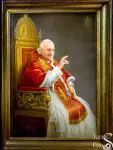
Saint John XXIII (1958-1963) was, on election, expected to be a caretaker pope; but, he became very influential. In 1962 he convened the second Vatican Council which saw almost 3,000 bishops come to Rome to discuss the Church and its position in a changing world. The portrait shown here is by the Franciscan Missionary Sisters of Mary. |

Saint John XXIII did not live to see the end of the Vatican Council which lasted three years. Blessed Paul VI (1963-1978) took over and is seen here in a portrait by the Franciscan Missionary Sisters of Mary. An artifact of his papacy is also seen here: a letter signed by Blessed Paul VI in gratitude for the rectification of the Ordo of the Divine Office dated 1966. (The Ordo gives complete details of the celebration of the Eucharist and the Liturgy of the Hours, beginning with the first Sunday of Advent.) |

A photograph by Arturo Mari, who served under six pontiffs, shows off the “smiling pope,” John Paul I (1978-1978). Sadly, John Paul I died after only 33 days in office. |

John Paul I’s passing led to the election of the second-longest serving pope and first non-Italian since 1523: John Paul II (1978-2005). John Paul II was influential and spiritual and was beloved by Catholics the world over. At his funeral Mass, crowds were shouting “Santo subito!” (Canonization now!). As a result, the five year waiting period was lifted and after a second miracle attributed to him, his canonization took place 27 April 2014. This print on paper is by Dina Bellotti. |
A lamp is kept lit in front of the Salus Populi Romani (Protector of the Roman People) icon of the Virgin Mary at the Basilica of Saint Mary Major. It’s said the icon was painted by Saint Luke the Evangelist (third Gospel and Acts of the Apostles author). It’s a Byzantine icon and has been venerated continuously since at least the 12th century. Saint John Paul II donated the beautiful votive lamp made of gilt silver shown here for that purpose. |
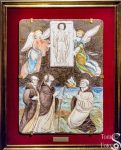
One of the gifts to Saint John Paul II is this painted pottery relief called Madonna of the Angels by the ceramists of Faenza. It represents a story in Dante’s Divine Comedy where angels took a 10th century Byzantine bas relief to Ravenna, a city often regarded as a link between eastern and western devotional traditions. |
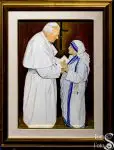
Blessed Mother Teresa of Calcutta was devoted to the poor and worked tirelessly on behalf of the neglected. She was awarded a Nobel Peace Prize in 1979 and the Missionaries of Charity is active in over 130 countries. Saint John Paul II and Mother Teresa enjoyed a close spiritual friendship. The 2002 portrait to the left by B. Alesky shows the pope with Mother Teresa. The statue shown to the right was given to Saint John Paul II in her memory on 5 September 2000, the third anniversary of her death. |

There are four Roman basilicas and each has a Holy Door which is sealed from the inside by bricks. Holy Doors are opened at the beginning of a Jubilee Year to allow pilgrims entrance. A Jubilee Year is a time of special grace and indulgence. This brick, dated 1983, is from the Holy Door of Saint Peter’s. (For the photographers, the line across the brick is actually part of the brick and not a shadow artifact of the lighting.) |
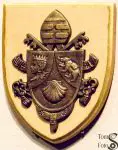
Upon the death of Saint John Paul II, Benedict XVI (2005-2013) was elected. He was the first German pope since Victor II in 1055 and at 78 when elected, he was the oldest to become pope since Clement XII in 1730. And, to continue the series, on 28 February 2013 he became the first pope since Gregory XII in 1415 to resign the papacy. We see here a bronze coat of arms and a 2008 portrait by Igor V. Babailov. |
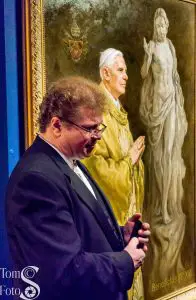
I was honored to be invited to the preview of the exhibit on 5 March 2016 and the artist, Mr. Babailov, was present. I managed to place myself in a position to take this photo of the artist and his work. It was quite an evening and I give a public “Thank You!” to the Ronald Reagan Presidential Library for the invitation. (He showed me a photo of the beautiful portrait he has done for Pope Francis. You can see it here on his website.) |
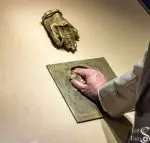
The last exhibit is a bronze cast of the hand of Saint John Paul II made by Cecco Bonanotte in October 2002. The most special part of this exhibit is that you are invited to press your hand against the hand of Saint John Paul II. It is the only exhibit you can touch in all ten galleries. (Not my hand.) |
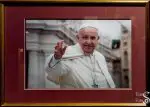
Less than a month from Benedict XVI’s resignation, on 13 March 2013, Francis became the 266th pontiff in a line extending back 20 centuries. He is the third non-Italian pope in succession having been born in Argentina. He has quickly become quite popular around the world. And, with his photo we end this page. |
